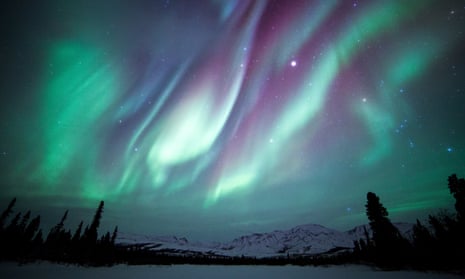There’s a hypnotic crackle before a whoosh of sound flies from ear to ear. It’s followed by a heavenly chorus that might be whales whistling, frogs calling or the chirping of an alien bird. It sounds celestial because that’s what it is. The noise is the aurora borealis: the northern lights.
The vivid green lights that trace across the Arctic sky emit electromagnetic waves when the solar shower meets the Earth’s magnetic field, and these can be translated into sounds that are made audible to human ears by a small machine.
These mysterious, sweeping noises are celebrated by a new Radio 3 documentary following the biologist Karin Lehmkuhl Bodony into the wilderness on her dog sleigh to record the soundscape, which has now been turned into music by an Alaskan composer.
Bodony lives in the remote Alaskan village of Galena. She can see the lights from her porch, and 16 years ago she discovered she could also record the sound of the lights using a very low frequency (VLF) receiver.
“To hear those ‘whoosh-whoosh’ sounds, which are so like what you see, is really special,” she says on a call from her home. “There are times when it’s just normal background chattery, crackly sounds and then there’ll be other times when it’s really cool – beautiful whooshing sounds and a chorus that sounds like frogs calling. If it was always the same it wouldn’t be as fun to go out and listen.”
For Songs of the Sky, which will be broadcast on Boxing Day, Radio 3 commissioned the composer Matthew Burtner, who works with natural sounds and scientific environmental data, to make a piece of music derived from the sounds of the aurora.
Northern lights listeners must get at least four miles away from human-made sounds and other electrical sources such as powerlines to avoid interference on the VLF receivers, so Burtner had to hike into the wilds with his daughter.
“What’s really surprising is that you can hear them at any time of day,” he says. “We tend to think of them happening at night because that’s when we see them but the fact that you didn’t have to be out at night was amazing. We could pull out the VLF recorder at any time and just listen to them through the cloud cover.”
Burtner found that the recordings from the device weren’t very clear and so mapped the sounds’ frequency and amplitude profile onto a high-quality synthesiser. “You can then alter the timbre of the sound and have the northern lights play different instruments. That let me really orchestrate with the northern lights, using their input as a controller,” he says.
“Rather than a composer writing the notes on the page and the musician playing the horn, the northern lights were playing the horn and writing the notes on the page. So I took myself out and let the lights paint that.”
Burtner created a six-minute piece that he hopes expresses the dialectic between humans and the natural world. “That’s what I’m always looking for in music – there’s something of the real natural system in there that’s untouched by a person.”
He believes there is more music to come from the northern lights. “The sounds themselves are quite varied. It will be interesting to keep recording and keep listening and discover new things about their behaviour. That could inspire different compositions based on the same subject. I don’t think my piece completes the expressive opus of the northern lights.”
The programme also explores the traditional meanings of the aurora borealis in the rapidly changing Arctic environment, where temperatures are rising faster than in many parts of the world.
According to Bodony, traditional Inuit interpretations of the northern lights are often benevolent, with the lights signalling to hunters how they will find food or reassuring the bereaved that their loved ones have passed to a better place.
But there are more sinister mythologies connected with the northern lights, which have symbolised danger in certain stories as well.
“Our atmosphere shields us from the sun’s radiation and manages to warm the planet but not too much – it’s a shield – and this display of the northern lights is a representation of the sun’s fearsome force on our planet that could make it uninhabitable,” says Burtner.
“It’s interesting that mythology here has led the science. A lot of Alaskan villages where that mythology was developed are experiencing severe global warming and severe melt, so much so that they’re having to relocate houses and whole villages because the coast has eroded because the ice doesn’t protect the coast anymore.”
For Bodony, the perspective derived from her rural subsistence culture – and the experience of the aurora borealis – can correct the wider human attitude to the planet, which is “like impudent children whose parent is away and we’re destroying the house”.
“We’re a culture dependent on our environment and integrated with it – not a power over it,” she says. “Often we’re drawn to natural experiences like the aurora borealis because they represent something that’s beyond ourselves. It makes you feel that you are a tiny part of a massive universe that’s outside of our control, and it’s very healthy in that regard.”
Between the Ears: Songs of the Sky is on BBC Radio 3 on 26 December at 11.45amGMT and available online shortly after broadcast.

Comments (…)
Sign in or create your Guardian account to join the discussion